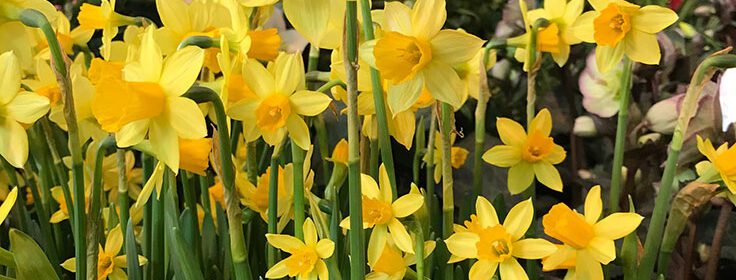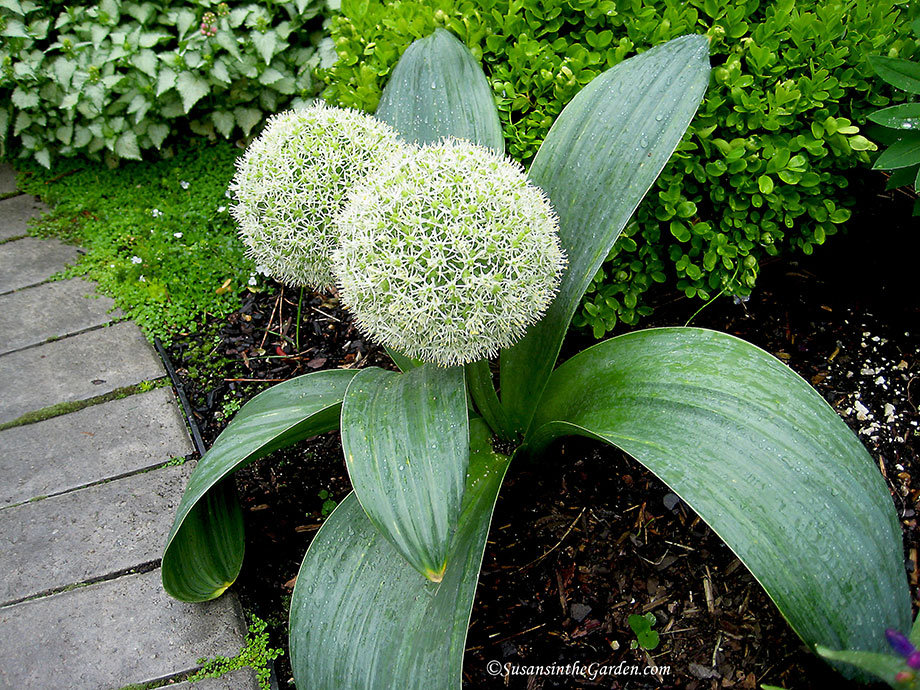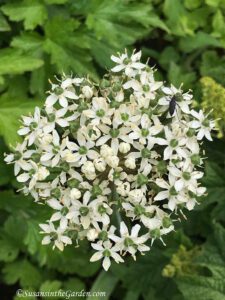Oct. 4 Column: Fall Bulbs

 Have you purchased any fall bulbs yet? Those are the ones you plant now so you can enjoy lovely flowers in the spring. That’s the topic of today’s garden column, which you can read in The Spokesman-Review: Go beyond tulips for beautiful bulbs. (or read it below the video)
Have you purchased any fall bulbs yet? Those are the ones you plant now so you can enjoy lovely flowers in the spring. That’s the topic of today’s garden column, which you can read in The Spokesman-Review: Go beyond tulips for beautiful bulbs. (or read it below the video)
I have a terrible time resisting fall bulbs. If you’re like me, you’re drawn to the displays in garden centers or all of the amazing bulbs in the catalogs that come in the mail. Try as I might, I just can’t resist them! And judging by a Sept. 29 Facebook post about this, many of you can’t either. It’s nice to know I have plenty of company, LOL.
In my column, I share information on bulbs that are deer- and rodent-resistant. While you might not have deer visiting your garden, so many folks have squirrels, chipmunks, pocket gophers, voles, and many other annoying creatures, so I thought it’d be good to focus on bulbs that *should* be safe from them. (I say *should* because we all know that some critters haven’t read the book on which things they’re not supposed to bother)
I also explain why Idaho gardeners and some Washington gardeners aren’t able to mail-order alliums, which are amazing bulbs that belong to the onion family. You might find that interesting.
The other thing I wanted to mention (which you’ll notice at the end of my column) is that this is my final column for the 2020 garden season. I know many of you are always saddened to read this each year but it’s time for my fall/winter break. And more so than ever this year because in addition to my column and video responsibilities, I’ve been working on my new book (The Vegetable Garden Pest Handbook) since February, so I need this little break more than ever. I am worn out!
The good news is that I’ll continue to write on my blog, post daily to my Facebook and Instagram accounts (@susansinthegarden), and I hope to shoot weekly videos, too. (yeah, I know, this won’t be a break from everything)
For this week’s “Everyone Can Grow a Garden” video, I had hoped to go over the planting of bulbs but my two orders haven’t arrived yet. Darn! That will have to be the subject of a future video. Instead, I went over some fall tasks such as overwintering geraniums and Canna lilies, the one time it’s OK to prune roses in the fall, and gave a quick update on what’s happening in our veggie garden. I hope you’ll enjoy it.
Here’s today’s column:
by Susan Mulvihill
I have a confession to make. Even though bulbs are probably the last thing I need more of in my garden, I just can’t help myself.
Bulb catalogs and garden center displays do this to me every time: Whenever I spot something new and unusual, it goes into my cart. I try reminding myself that I’ll have to dig a hole for every bulb I purchase, but it doesn’t seem to make a difference.
Fall is the time to plant bulbs that will bloom in the spring. The most commonly-grown types are tulips, daffodils and crocuses. I think tulips are gorgeous but there’s a problem. Since gophers and deer think they are delicious, I have to focus on bulbs that are rarely bothered by them.
As members of the onion family, alliums really fill the bill and they come in a variety of sizes. Ivory Queen has wide, strap-like gray-green leaves, large white flowers and are just 8 inches tall. Nigrum is an heirloom variety with small white blossoms and grow on 2-foot-tall stems. The downside to alliums is that the state of Idaho and five Washington counties (Adams, Benton, Franklin, Grant and Klickitat) do not allow the shipment of alliums due to quarantine laws designed to protect onion crops from white rot disease.
Fortunately, we gardeners have other options for deer- and rodent-resistant bulbs. I’ve long admired crown imperial fritillaries (Fritillaria imperialis) both for their beauty and gopher-repelling qualities. The bulbs are rather expensive which has always put me off. This year, I decided to buy a bulk package to take advantage of a better price and add crown imperials to my garden. They grow an impressive 36 inches tall and feature either bright yellow or orange flowers.
Other attractive fritillaries are Guinea hen flowers (F. meleagris) with their checkered petals and a height of 12 inches, and Persian lily (F. persica) with cream-, plum- or mahogany-colored flowers and a 30-inch height.
Daffodils, which belong to the genus Narcissus, are appreciated for their bright, perky appearance and the fact that deer and rodents avoid them. I love how their flowers never get smaller over the years (like tulips typically do) and they multiply, giving you more bang for your buck. Most gardeners are familiar with the all-yellow King Alfred daffodils, but there are so many more to choose from. Three cultivars that feature white petals with peach-colored trumpets are British Gamble, Martha Stewart and Salome. All-white Thalia has multiple blossoms per stem and a sweet fragrance.
Foxtail lily (Eremurus) is a real showstopper at 4 to 5 feet in height and has flower spikes in white, apricot, yellow and pink. After admiring them in Claude Monet’s beautiful French garden last summer, I just had to add them to my bulb order.
Once you get your bulbs, unpack them and plant them before the ground freezes. The packaging will tell you how deeply to plant them and how far apart to space them. Good soil drainage is important. I recommend adding some bulb fertilizer or bonemeal to the holes; be sure to follow the label instructions. Mark your plantings so you won’t forget where they are. Next year, you’ll have some lovely additions to enjoy in your garden.
This is my final column of the 2020 garden season. I will continue to write about all aspects of gardening on my blog (Susansinthegarden.com) and Facebook page (facebook.com/susansinthegarden) so please drop by for a visit.
Susan Mulvihill is author of “The Vegetable Garden Pest Handbook.” She can be reached at Susan@susansinthegarden.com. Watch this week’s “Everyone Can Grow a Garden” video at youtube.com/susansinthegarden.

